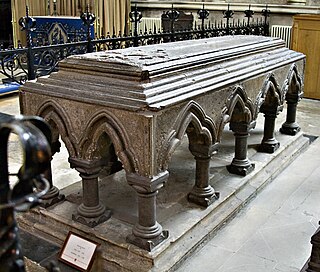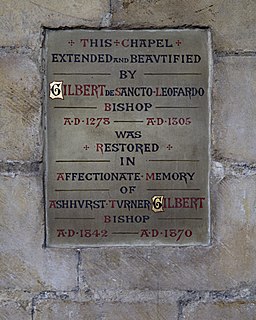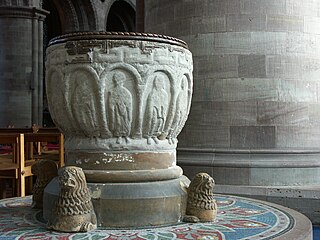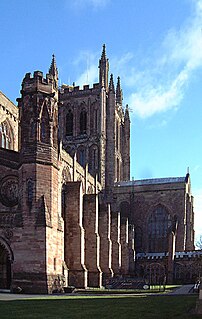Related Research Articles
Eustace was the twenty-third Lord Chancellor of England, from 1197 to 1198. He was also Dean of Salisbury and Bishop of Ely.
John Chishull or John de Chishull was Lord Chancellor of England, Bishop of London, and Lord High Treasurer during the 13th century. He also served as Dean of St Paul's.
Walter Giffard was Lord Chancellor of England and Archbishop of York.

Sewal de Bovil was a medieval Archbishop of York.
Henry of Newark was a medieval Archbishop of York.
Savaric fitzGeldewin was an Englishman who became Bishop of Bath and Glastonbury in England. Related to his predecessor as well as to Emperor Henry VI, he was elected bishop on the insistence of his predecessor, who urged his election on the cathedral chapter of Bath. While bishop, Savaric spent many years attempting to annexe Glastonbury Abbey as part of his bishopric. Savaric also worked to secure the release of King Richard I of England from captivity, when the king was held by Emperor Henry VI.
William Langton was a medieval English priest and nephew of Archbishop Walter de Gray. William was selected but never consecrated as Archbishop of York and Bishop of Carlisle.
William of Bitton was a medieval English Bishop of Bath and Wells.
William of Bitton was a medieval Bishop of Bath and Wells.

Gilbert de St Leonard was a medieval Bishop of Chichester.
Ralph Walpole was a medieval Bishop of Norwich and Bishop of Ely.

Robert Foliot was a medieval Bishop of Hereford in England. He was a relative of a number of English ecclesiastics, including Gilbert Foliot, one of his predecessors at Hereford. After serving Alexander, Bishop of Lincoln as a clerk, he became a clerk of Henry of Blois, the Bishop of Winchester and brother of King Stephen of England. He attended the Council of Reims in 1148, where another relative, Robert de Chesney, was elected as Bishop of Hereford. Chesney then secured the office of Archdeacon of Oxford for Foliot.
Hugh Foliot was a medieval Bishop of Hereford. Related somehow to his predecessor at Hereford, he served as a priest and papal judge as well as being an unsuccessful candidate as Bishop of St David's in Wales. In 1219, he was appointed Bishop of Hereford. During his time in office, he mostly attended to ecclesiastical duties, but did occasionally serve as a royal administrator. He helped found a hospital and a priory, and died in 1234 after a months-long illness.
Ralph of Maidstone was a medieval Bishop of Hereford.

Richard Swinefield was a medieval Bishop of Hereford, England. He graduated doctor of divinity before holding a number of ecclesiastical offices, including that of Archdeacon of London. As a bishop, he dedicated considerable efforts to securing the canonisation of Thomas de Cantilupe, his predecessor, for whom he had worked during his lifetime. Active in his diocese, he devoted little time to politics. He was buried in Hereford Cathedral where a memorial to his memory still stands.
Henry of Lexington was a medieval Bishop of Lincoln.
Oliver Sutton was a medieval Bishop of Lincoln, in England.
Richard de Belmeis was a medieval cleric, administrator and politician. His career culminated in election as Bishop of London in 1152. He was one of the founders of Lilleshall Abbey in Shropshire.
Henry of Sandwich was a medieval Bishop of London.
Richard Gravesend was a medieval Bishop of London.
References
- Barrow, J. (2002). Fasti Ecclesiae Anglicanae 1066-1300: Volume 8: Hereford: Treasurers. Institute of Historical Research. Retrieved 28 October 2007.
- Fryde, E. B.; Greenway, D. E.; Porter, S.; Roy, I. (1996). Handbook of British Chronology (Third revised ed.). Cambridge, UK: Cambridge University Press. ISBN 0-521-56350-X.
- Greenway, Diana E. (1977). "Archdeacons of Oxford". Fasti Ecclesiae Anglicanae 1066–1300. Vol. 3: Lincoln. Institute of Historical Research. Retrieved 28 October 2007.
- Greenway, Diana E. (1977). "Bishops of Lincoln". Fasti Ecclesiae Anglicanae 1066–1300. Vol. 3: Lincoln. Institute of Historical Research. Retrieved 28 October 2007.
- Greenway, Diana E. (1977). "Deans". Fasti Ecclesiae Anglicanae 1066–1300. Vol. 3: Lincoln. Institute of Historical Research. Retrieved 28 October 2007.